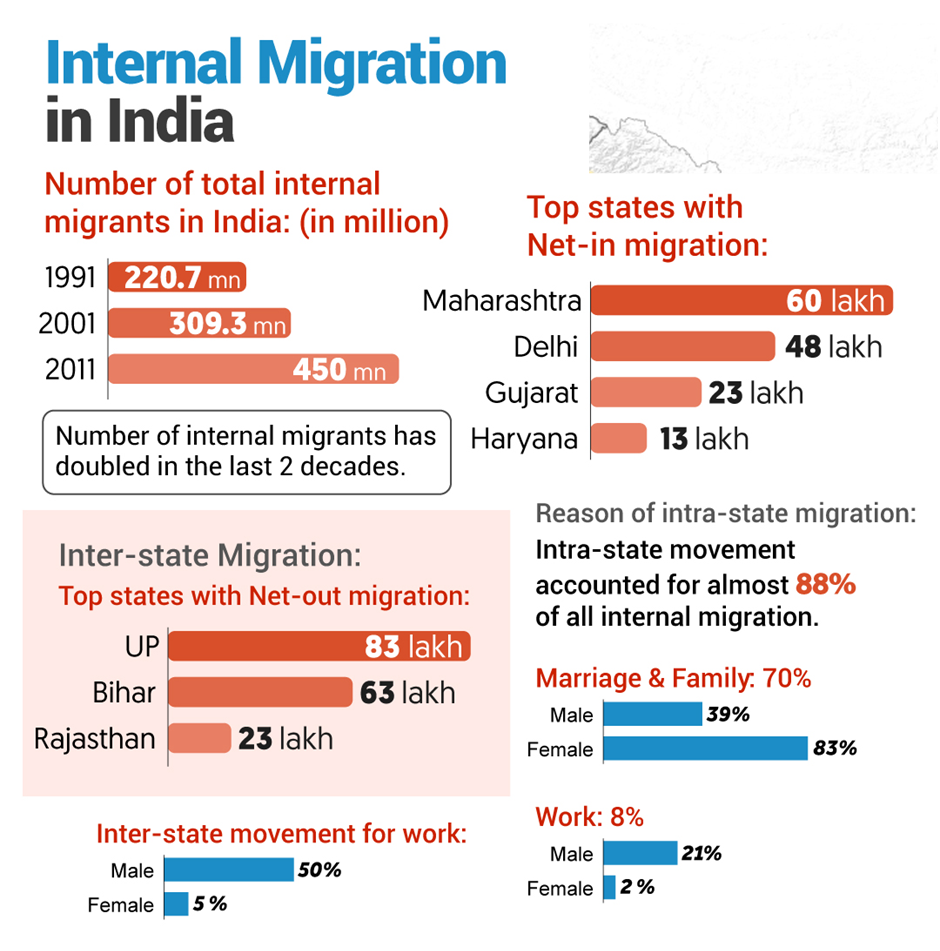MAKING SPACE FOR MIGRANTS IN MANIFESTOS
Relevance: GS 2 – Issues relating to development and management of Social Sector/Services relating to Health, Education, Human Resources.
Why in the News?
- The 2024 Lok Sabha election manifestos of both the BJP and Congress have acknowledged migrants’ concerns for the first time.
- The COVID-19 pandemic and ensuing lockdowns highlighted the vulnerability and disenfranchisement of India’s estimated 600 million internal migrants.
Importance of acknowledging Migrants contribution
- Migrants, despite their significant contribution to the economy, have historically been overlooked by policymakers.
- Both parties have made promises aimed at addressing migrant issues, reflecting a growing recognition of their importance.
- However, critical areas affecting migrants’ welfare might have been overlooked in these promises.
- It is crucial to scrutinize these promises to ensure effective inclusion of the vast migrant population in India.
Manifesto of BJP and Details associated with it
- Modi ki Guarantee for Shramik Samman:
- The manifesto pledges to engage with migrant workers registered on the e-Shram portal, aiming to address the issue of their invisibility due to lack of documentation.
- While acknowledging the importance of creating a credible database of migrants, it fails to address challenges such as Aadhaar-seeding and technical infrastructure issues with the e-Shram portal.
- There’s a lack of clarity regarding the benefits for workers post-enrolment on the portal, beyond accident insurance.
- Enhancing Special Train Services:
- The BJP promises to expand Special Train Services for migrant workers, intending to provide regular connectivity throughout the year, rather than seasonally.
-
-
- This move aims to facilitate easier transportation for the significant number of inter-State migrants in India.
-
- Periodic Review of National Floor Wages:
- The manifesto commits to periodically reviewing the National Floor Wages, considering the minimum living standards of workers, which could particularly benefit daily wage migrant workers.
- However, critics express concerns that this initiative might inadvertently push workers into exploitative conditions, and regional wage variations may trigger migration imbalances.
- Implementation of Social Security Measures:
- Plans are outlined to implement post office savings, accident and life insurance, and social security measures for workers using digital technologies.
- However, the effectiveness of this approach is questioned, given challenges such as digital literacy, affordability, and infrastructure disparities, which could exacerbate existing divides.
- Neglect of Vulnerable Groups:
- The manifesto overlooks the specific challenges faced by women, children, and young migrants, failing to address their unique needs.
- Despite the existence of a draft National Migrant Labour Policy prepared by NITI Aayog, there’s no mention of its implementation in the manifesto.
- Development Approach and Electoral Reform:
- The BJP manifesto promotes a ‘city-centric development’ approach but remains silent on sustainable village development, potentially exacerbating distress migration to urban areas.
- Additionally, the promise of implementing ‘One Nation, One Election’ raises concerns about depriving migrant votes of their representation in electoral processes.
Manifesto of Congress’ and Details associated with it
- Regulation of Migrant Employment: The Congress pledges to enact a law to regulate the employment of migrant workers, ensuring their fundamental legal rights and social security.
- Strengthening Social Welfare Programs:
- Promises to update ration card holders and expand the coverage of the Public Distribution System (PDS), allocating sufficient funds to both PDS and the Integrated Child Development Service.
- Intends to launch a mid-day meal scheme benefiting migrants, though silent on PDS portability.
- MGNREGA and Minimum Wage:
- Commits to increasing the wage under MGNREGA to ₹400 per day and maintaining it as the national minimum wage, crucial for rural migrants and reducing distress out-migration.
- Urban Employment Scheme:
- Pledges to launch an urban employment scheme for the urban poor, potentially beneficial for urban migrants as well.
- Gender Equality and Women’s Welfare:
- Aims to enforce the principle of ‘Same Work, Same Wages’ to prevent gender-based discrimination.
- Focuses on women’s welfare, promising to build sufficient night shelters for migrant women workers and safe and hygienic public toilets for women in towns and cities.
- Missed Opportunities and Overlooked Issues:
- While migrant issues are addressed, the manifesto could be more effective by addressing specific challenges faced by migrant women and identifying issues like exploitative labor markets, fragmentation, and forced labor conditions.
- Critical areas such as public health inclusion, education for migrating children, housing, water, sanitation, legal aid, and dispute resolution are overlooked.
- Emphasizes that only political will can truly change the lives of migrants and their families, indicating a need for broader systemic changes.
Source: https://www.thehindu.com/opinion/op-ed/making-space-for-migrants-in-manifestos/article68118338.ece
Mains question
Discuss the promises made by parties in their 2024 election manifestos regarding migrant welfare. Assess the effectiveness and identify overlooked areas. (250 words)




